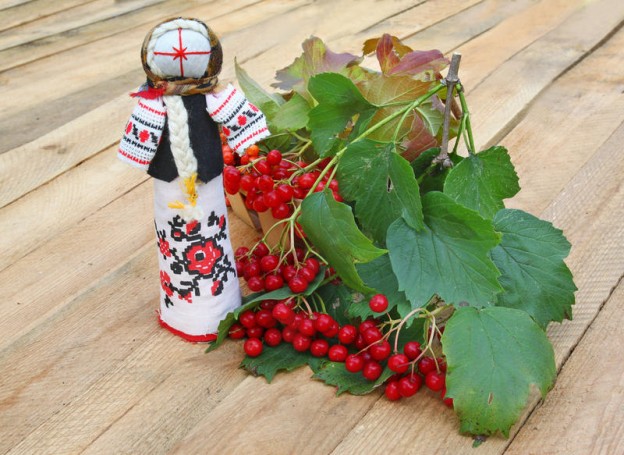The beauty Kalina is more and more often found in gardens, country houses and on city streets. The plant is unpretentious, does not require special care. In addition to decorative qualities, viburnum has many healing properties.
Table of contents
Features planting viburnum in the fall
Planting and caring for a plant does not require special difficulties and difficulties. Viburnum grows well on neutral and weak acidity of the soil (pH 5.5-6.5).Sand, peat and podzolic soil are not suitable. The depth of the soil is not less than one meter.
Kalina prefers that the site of her location is well lit, but grows well in shady places. According to some experts, viburnum in the shade less attracts pests.
Viburnum is planted both in spring, when the leaves did not appear, and in the fall, when the leaves have already fallen. Before planting, the earth is dug up and freed from weeds. Fertile soil does not require the application of organic fertilizers. It is necessary to fertilize poor soil only immediately before planting.
Before planting, a recess with a diameter of 60 cm and a depth of half a meter is excavated. The distance between the pits should be at least one and a half meters. The soil of the pit is mixed with organic and mineral fertilizers. One recess requires:
- humus or peat (10 liters);
- potassium sulphate (1/2 cup);
- superphosphate (1 cup);
- dolomite flour (1 cup);
- urea (2 tbsp.)
Everything is thoroughly mixed and filled to 2/3 in the recess.Then the soil mixture is poured with 3-4 buckets of water. Within 6-7 days the hole is moistened. During planting, the remaining mixture is poured into the hole, so that a bump appears, the height of which should be 10-12 cm. A seedling is placed on the tubercle in an upright position, covered with soil and compacted. Then a hole is made in the near-ground circle and watering is performed.
Mulching is carried out in late spring, when the soil is warm and moist. Mulch in the form of shredded tree bark, wood chips or peat is scattered around the bush.
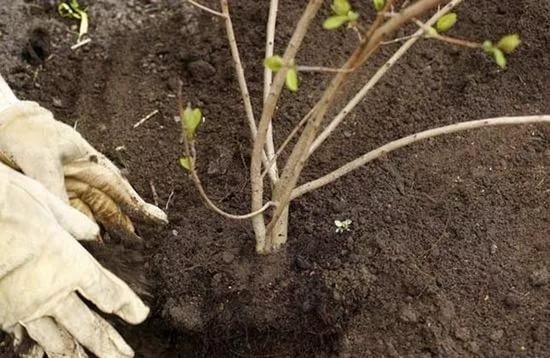
Advantages of autumn planting and transplanting in open ground
It is known that it is possible to plant viburnum both in spring time (end of April - beginning of May), and in autumn (September). According to experienced gardeners, planting in the fall has some advantages:
- landing is best done in early September, so that the seedlings have time to take root;
- in autumn, the soil around the plant will settle, it will become dense;
- in the autumn period there is no strong heat, therefore, there is no need for frequent watering;
- The seedling that was planted in the autumn, grows green in the spring, as the roots develop and the bud is asleep at the time, thanks to which the young shoots develop more actively;
- spring in the garden and the garden a lot of things, so in the fall, when there is more free time, you can start planting viburnum.
Care: how to plant and trim bushes?
It is also necessary to care for viburnum, as for other cultivated plants: destruction of weeds, regular watering, loosening of the soil in the near-stem circle, mulching, cutting and crown formation, fighting diseases and pests.
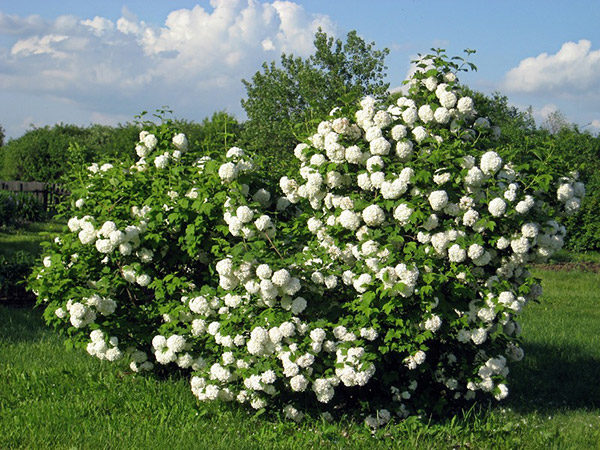
Watering
Watering is done in the evening, shedding the soil by 40 cm. Adult bushes should be watered during the growing season and when the berries ripen.
Feedings
Usually top dressings are produced in a dry form, in hot, dry weather they are best dissolved in water. You need to feed the plant several times:
- In early spring, when young leaves bloom. Urea is introduced (2 tbsp. L.);
- Fertilizer is applied immediately before flowering. Spread wood ash (1/2 liter) or potassium sulphate (2 tbsp. L.);
- Supplemented after flowering. Introduced nitrophoska or nitroammofoska (2 tbsp. L.).
- Liquid feeding is made in October, when the harvest is already gathered. Potassium sulfate (2 tablespoons) and superphosphate (3 tablespoons) are added to ten liters of water. For each bush viburnum requires two buckets of fertilizer
Reproduction and cultivation
Viburnum can be propagated by dividing the bush, seeds, cuttings and layering. After breeding, shoots can be transplanted into open ground.
Reproduction by dividing the bush
Usually this method is used if the species of viburnum is valuable and needs to be preserved or transplanted to another place. The plant is divided into several parts. At least 3 buds remain on each part. Separation and transfer are made in spring or autumn.
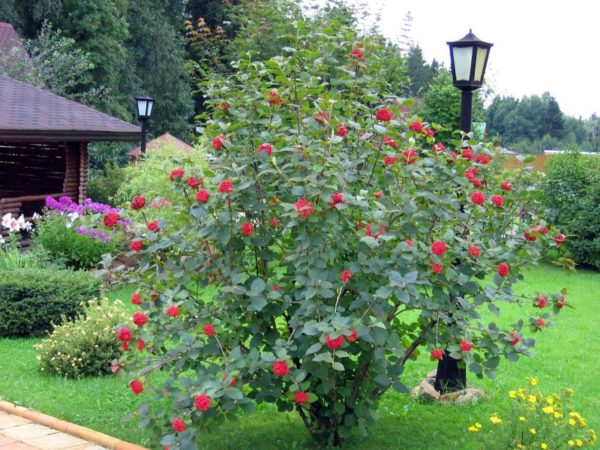
Reproduction by cuttings
In June or early July, when the branches are flexible, harvesting begins. When cutting it is necessary to monitor the number of nodes, there should be at least three. Length of planting material, approximately 10 cm.At the bottom of the cutting is an oblique cut, the leaves are cut. The material is desirable to hold the drugs to accelerate growth (Kornevina). Then place the cuttings in a greenhouse, deepening 2 cm into the ground. The soil mixture is prepared from equal parts of sand and peat. When rooting greenhouse covered with plastic wrap or glass.
Cuttings require constant watering. Before winter, rooted shoots are insulated. Sawdust, roofing material and peat are used as covering material. In the spring of planting material landed in a permanent place of residence.
How to propagate by layering?
Near the bush of viburnum spring break through the grooves. Young shoots bend from the bush and covered with soil and fastened with wire. The tip should remain on the surface. Slightly above the poured soil, an incision is made on the shoot. By the fall, the layers will give roots, young shoots will appear on the buds. The processes are separated from the adult plant and transplanted to a new place.
Propagation by seeds is not welcomed by gardeners, as it takes a long period of time before germination.The technology is somewhat more complicated. As Vida., Viburnum can multiply in many different ways.
Pruning
Cut the plant can be both in autumn and early spring. Kalina definitely need sanitary and anti-aging pruning. In addition, pruning forms the volume of the plant. Pruning in early spring each year limits the size of the bush and increases the illumination in the crown. Also weak diseased branches are removed.
Next, cut out the old 7-9-year-old branches, which have already otplodonosili. Leave only strong, annuals. Shrubs with weak flowering are cut off completely. Hemp remains, protruding 15-20 cm above the ground. Dormant buds give young shoots and viburnum is restored very soon.
When the bush is not cut for a long time, it thickens, loses its beauty. Anti-aging pruning is done after waking up the kidneys. Old branches are cut or sawn with a secateur, small hemp five centimeters long remain. From hemp appear young shoots. Over the summer, weak branches are removed on the shoots.
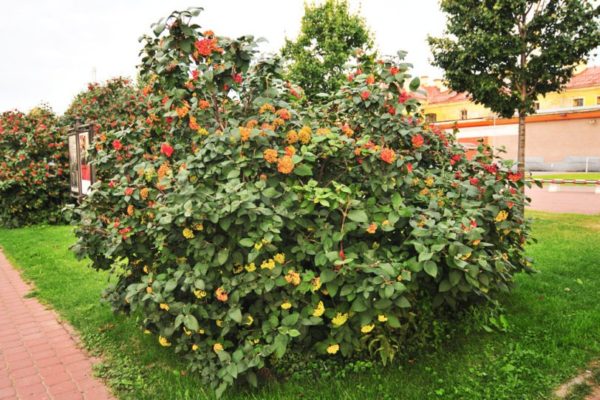
Formation
Unlike other fruit bushes, Kalina does not require frequent pruning of shoots. Usually remove shoots once a year.
When a plant is formed by a bush, in spring all branches are removed by 2-3 knots. Growth points pinch when reaching a length of 30 cm. Awakened buds will give young shoots. They will be the main component of the plant. AT subsequent years systematic pruning viburnum form the desired size of the bush.
If you want to see viburnum tree, at the beginning of the formation you need to leave a vertical central trunk. The remaining side branches should be removed. Growth around the bush is also trimmed. In 2-3 years, a trunk will be formed with a height of about two meters. The crown is formed by pinching a growth point. The tip of the conductor is clipped and several buds appear at the cutoff site. Thanks to this procedure, the tree becomes branched.
Grow viburnum on your own site is easy. You need to competently be able to care for her. Then the plant will appreciate the magnificent flowers and beautiful healthy berries.
